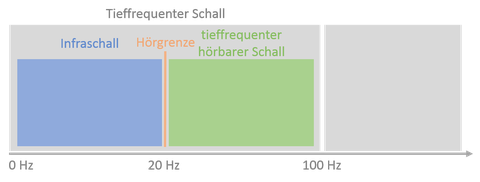Low-frequency sound
The effect of noise on humans is one of the core areas of research at the Chair of Acoustic and Haptic Engineering. Interaction of different perceptual modalities, especially tactile and auditory modalities, are of particular interest. In recent years, potential positive (sportiness of vehicles, perception of music ...) and negative effects (noise pollution ...) are being investigated, by considering the lower frequencies.
Recently, the topic of low-frequency noise, particularly effect of infrasound, has become increasingly important. Infrasound is the sound waves below the human hearing range (between 0.1 Hz to 20 Hz, while the human hearing range is about 20 Hz to 20 kHz), while definition of the low-frequency sound is below 100 Hz. Due to the large wavelength, low-frequency emissions may spread over long distances. They can spread as direct airborne sound and / or as vibrations or secondary sound.
The perception of low-frequency noise components differs significantly from medium or high frequencies. Pulsation or vibration sensed by also other organs since low frequency noise make them to vibrate, and it creates pressure in the ears hence feelings of anxiety are generated. As soon as the sounds are within not-audible frequency range (<20 Hz), they are usually referred to as "booming" or "humming".
Low-frequency sound occurs in many areas. Due to the increase in need for more complex technical equipment also low-frequency sound increases. For example, pumps, compressors, vehicles and wind turbines can cause low-frequency noise. Noise generated by wind turbines with frequently recurring level fluctuations is repeatedly reported as the cause of nuisance or impairment. The noise of wind turbines is usually between 3 Hz and 16 kHz. In residential areas, low-frequency noise emissions are transmitted especially when other noise levels are low (at night). As a result, the nuisance effect is particularly high here.
But even in large vehicles such as commercial vehicles, low-frequency noise components can be very pronounced and the frequency ranges of audible sound and vibrations such as whole-body vibrations can overlap and cause annoyance to drivers. Such interactions due to the different signal contents of both stimuli are currently the subject of research at the Chair of Acoustics and Haptics.
In the field of noise impact research, experiments are often carried out with psychophysical perception tests and physiological measurements under various types of noise. These measurements and experiments are carried out at the chair mainly in the multimodal measuring laboratory, since the simultaneous presentation of acoustic, optic and vibratory stimuli to subjects make it possible to obtain information about interactions between different modalities. Through elaborate room acoustic measures, the laboratory has been optimized for the reproduction of low frequencies (room-in-room construction, avoidance of parallel walls, large tunable Helmholtz resonators in all room corners ...).
Contact:
Mitarbeiterin
NameMs Dipl.-Ing. Maria Mareen Maravich
Send encrypted email via the SecureMail portal (for TUD external users only).
Professur für Akustik und Haptik
Professur für Akustik und Haptik
Besucheradresse:
Barkhausenbau, Raum BAR 63 Helmholtzstraße 18
01062 Dresden
None

